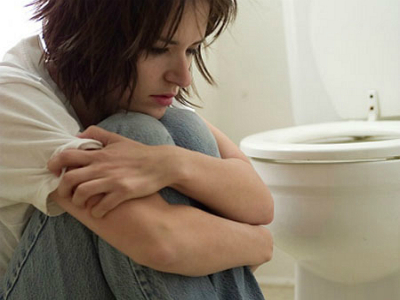1 Etiology of symptom
A stool with blood is often seen in people suffering from hemorrhoids. Blood droplets can be seen on toilet paper, as in most cases the bleeding is not strong and it appears after the departure of a hard stool. But everything will depend on the severity of the disease. If the hemorrhoidal nodes are large and the disease is in a neglected state, serious bleeding may open and not only after the bowel has been emptied. In addition, hemorrhoids are accompanied by a symptom such as pain in the anus. Hemorrhoids can be internal, and therefore their presence is not always known to the patient. When there is a suspicion of hemorrhoids, you can contact the proctologist.

Recommended to read
- What can the stool with blood indicate?
- What is the signal of the appearance of blood from the anus
- What is amebiasis
- Effective remedy for gastritis and stomach ulcer
If there is blood in the stool, the reasons can be:
- Infectious diseases. Bacteria and viruses that enter the intestine damage the vessel walls. As a result, blood clotting occurs, the veins of which can be seen in feces. There is a sufficiently large number of pathogens, which can lead to the appearance of blood impurities in the stool. One of the most dangerous infectious diseases is dysentery. The patient has severe abdominal pain, chills, signs of intoxication, fever, general weakness and loose stool. Desires for defecation are frequent, up to 20 times a day, in addition, they can be false. Another no less dangerous infectious disease is amoebiasis. It is characterized by a loose stool with an admixture of blood and mucus. Diverticulitis( inflammation of the hernial protrusions of the walls of the small or large intestine).The lack of correct and timely treatment leads to the development of a chronic form of the disease, which leads to the formation of an ulcer of the intestine. Intestinal infections, accompanied by a bloody liquid stool, are dangerous not only for the patient himself. They can be contagious. That is, if you do not start treatment, the whole family and other people around you can get sick. Infectious diseases often cause death.
- Diseases of the rectum and anal opening. In addition to hemorrhoids, there are other diseases of the anus, which can lead to the appearance of an admixture of blood in the feces. The presence of blood can be caused by polyps of the rectum, constipation, tumor growths, rectal fissures, damage to the anus or rectum during rectal temperature measurement, examination, enema installation and other.
- Diseases of the digestive system. Blood in the stool with diseases of the gastrointestinal tract may differ depending on the disease. In case of intestinal obstruction, in addition to sharp pain in the lower abdomen, the patient has a jelly-like stool in which blood is present. For ulcerative colitis and Crohn's disease, which cause inflammation of the intestinal mucosa, the appearance of blood veins in the stool is characteristic. Black feces may indicate an expansion of the esophagus, cirrhosis of the liver or stomach ulcers. Blood veins in fecal masses can also occur with dysbacteriosis, especially after prolonged diarrhea.
-
 IMPORTANT TO KNOW! Gastritis? Ulcer? To have a stomach ulcer not turned into cancer, drink a glass. ..Read the article & gt; & gt;
IMPORTANT TO KNOW! Gastritis? Ulcer? To have a stomach ulcer not turned into cancer, drink a glass. ..Read the article & gt; & gt;
The appearance of blood in the stool can be triggered by the use of certain drugs containing potassium, which damages the walls of the intestinal tract. Seen blood in feces can also indicate the presence of parasitic organisms in the intestinal tract, an abnormality of the vessels of the intestinal tract, and so on. With salmonellosis, in addition to pain in the navel, blood stools are often observed.
-
 Gastroenterologist. VAZHENOV: "I beg you, if you started to worry about abdominal pain, heartburn, nausea, do not do gas in any way. .."Read more & gt; & gt;
Gastroenterologist. VAZHENOV: "I beg you, if you started to worry about abdominal pain, heartburn, nausea, do not do gas in any way. .."Read more & gt; & gt;
Due to the large number of possible diseases, it is recommended to trust the diagnosis only to a specialist.
2 The latent problem
The liquid stool with an admixture of blood clearly indicates the presence of health problems. But such symptoms are peculiar to diseases that are in aggravation, and have a serious destructive effect on the body.

There is a special analysis for the presence of latent blood in the stool, which helps to identify many diseases at the initial stage, when the disease is still asymptomatic.
The significance of this analysis is that it helps to identify even the smallest traces of blood that are not visible to the naked eye. With its help determine the latent bleeding in the stomach or other digestive organs, cancer in the early stages, adenomatous polyps and other diseases. The only difficulty of this analysis is that it must be taken correctly, since the slightest bleeding gums, improper eating or taking certain medications may distort the results of the study. For this reason, doctors often recommend taking the test again, regardless of whether the result was positive or negative. Before you take the test, the doctor tells you how to properly prepare yourself.
TIP FROM THE MAIN GASTROENTEROLOGIST
Korotov SV: "I can recommend only one remedy for the rapid treatment of Ulcer and Gastritis, which is now recommended by the Ministry of Health. .." Read the reviews & gt; & gt;
If latent blood in the feces was not detected and after repeated examination, but other symptoms persist, additional tests are prescribed to diagnose the problem.

On the one hand, the presence of bloody traces in feces is bad, on the other - a symptom helps to learn about the disease in the gastrointestinal tract. To maintain their health, doctors recommend that the test be taken annually, even if there are no additional symptoms.
3 Necessary treatment for
After the blood was found in the feces analysis( or it is visible to the naked eye) and additional diagnostics were performed to find out the cause of its appearance, the doctor prescribes treatment. It will be aimed at eliminating the underlying pathology and accompanying symptoms.
Treatment is conservative and surgical. In some situations, when the bleeding is intense, immediate surgical intervention may be required. Otherwise, everything can end badly.
During treatment, regardless of the method, the patient should adhere to a diet that excludes from the diet heavy food. It is recommended to refuse from acute, sour, salty, fatty, roast, smoked, bitter and not to drink alcohol. If the disease is in an exacerbation, you can not exert strong physical activity on the body. If there are constipation, softening enemas are prescribed.
Any treatment, regardless of its complexity, should include itself taking medications that enhance and support the functioning of the immune system.
Treatment with folk remedies, as well as medical therapy, should be prescribed only by a qualified specialist on the basis of the results of the survey. It is not recommended to try to cope with the problem independently. There is a possibility of aggravating the problem.
- 1 Etiology of symptom
- 2 Concealed problem
- 3 Treatment required
A stool with blood in an adult is an alarming symptom that can not be ignored. There are many diseases that lead to the appearance of blood in the feces. Some of them are associated with problems of the digestive tract, but there may be other causes of blood that are not related to the gastrointestinal tract. In addition to blood in the feces, other impurities, such as pus or mucus, are possible. Health problems of this nature can be observed not only in an adult. Virtually all of the below listed pathological factors may be present in the child.
Do you have gastritis?
GALINA SAVINA: "How easy is it to cure gastritis at home for 1 month. A proven method is to write down a recipe. ..!"Read more & gt; & gt;



